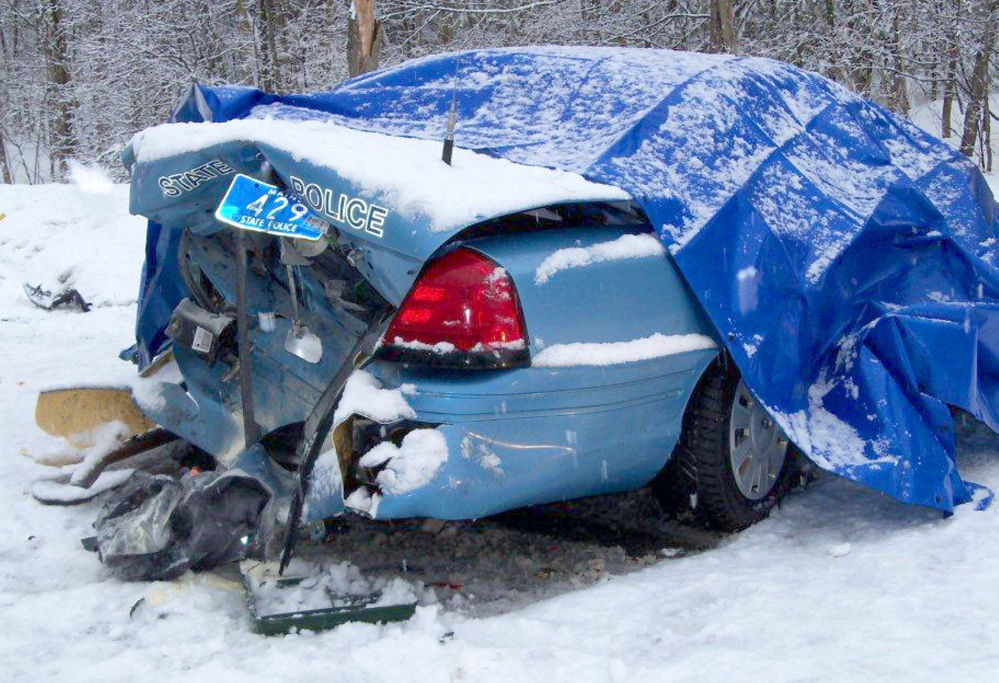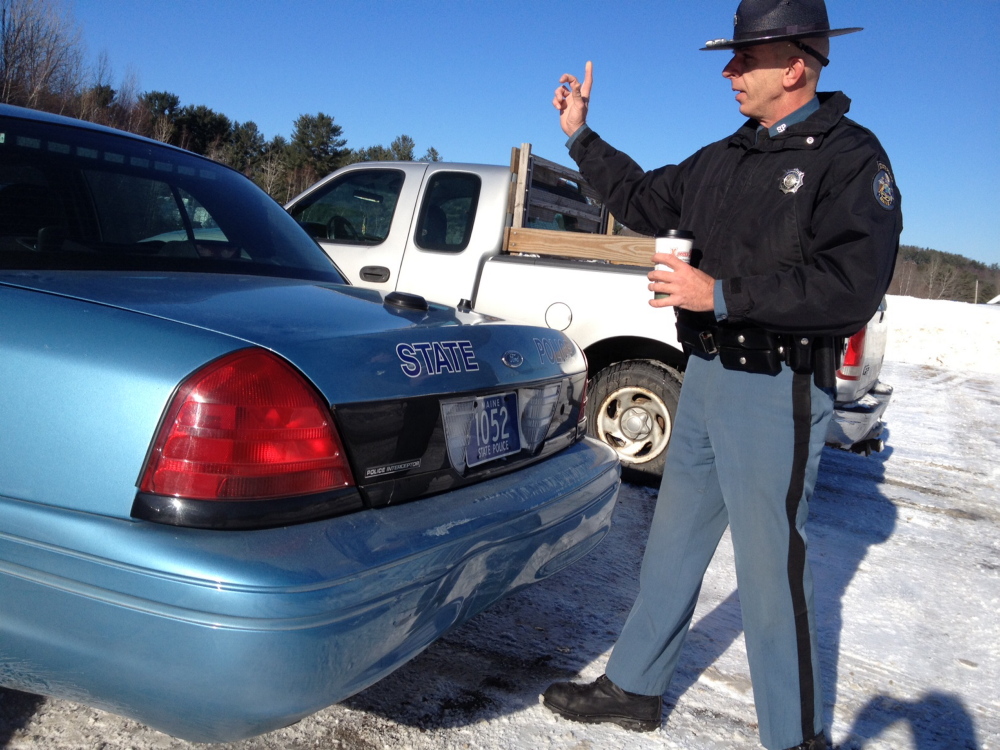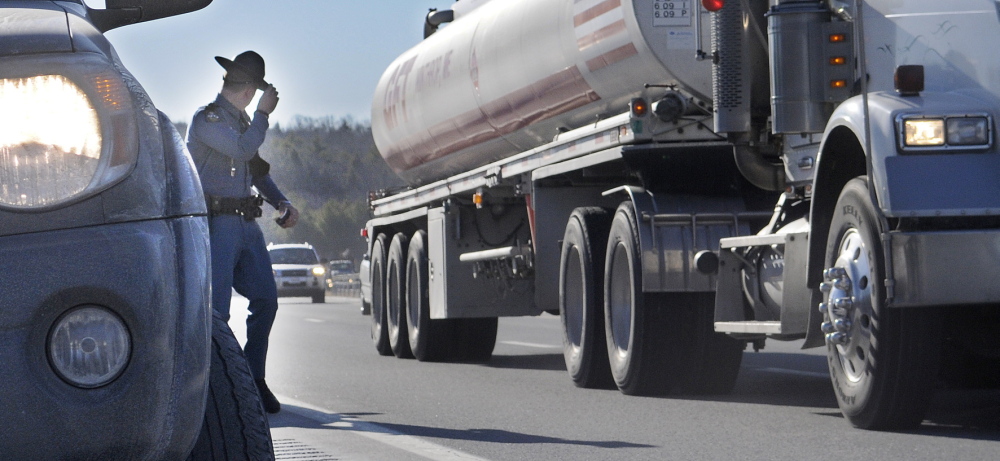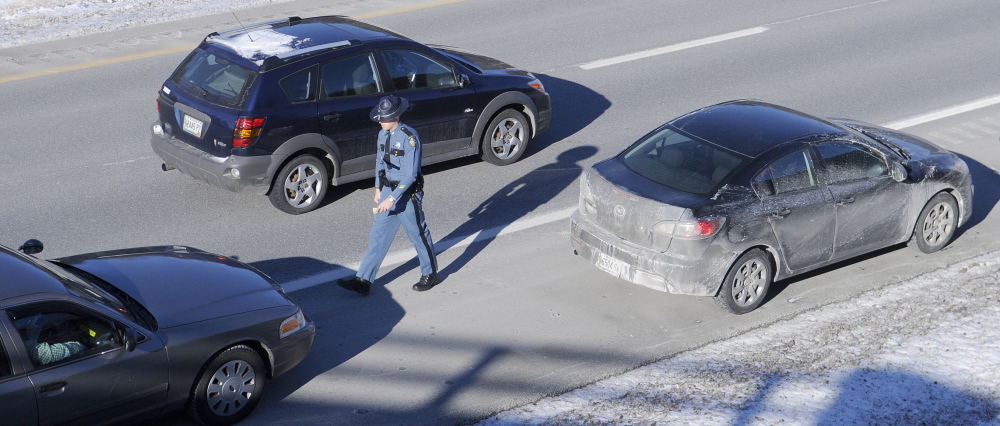WEST GARDINER — State Police Trooper Christopher Rogers looks in his driver’s side mirror, waiting for a chance to open his door and climb out as a steady stream of cars speed by just a couple feet away. Every one of those drivers, apparently oblivious to the flashing blue lights that mark Rogers’ cruiser, is not only breaking the law, they are a very real threat to Rogers’ life.
“If I opened my door now, they’d take it off,” Rogers said, still peering into the mirror. “They’ve got plenty of room to see what’s going on. They’ve got plenty of room to move over. Instead they put two hands on the wheel and pray.”
State Police are renewing pleas to drivers to slow down and give parked emergency vehicles plenty of room after two troopers were injured and two cruisers were destroyed in crashes over the Thanksgiving weekend.
Trooper William Baker was hurt Dec. 1 when his cruiser was broadsided by a car that slid out of control on the Maine Turnpike in York as he was investigating another crash. Trooper Samuel Tlumac was hurt later that same day when his cruiser was rear-ended while he was parked at a crash site on Interstate 95 in Pittsfield. None of the injuries proved to be serious. Both accidents occurred on snow-covered roads, and both were at least in part caused by drivers who failed to obey a state law that requires motorists to slow down and move over as far as possible when approaching an emergency vehicle from behind.
“We as troop commanders almost cringe when the phone rings during a snowstorm,” said State Police Lt. Aaron Hayden, commander of Augusta-based Troop D. “We can almost guarantee the loss of a cruiser somewhere in the state. We just hope we don’t have an injured trooper to go with it.”
Hayden said drivers have become accustomed to obeying the law that requires drivers to pull over to the right when an emergency vehicle is approaching from behind, but many motorists fail to obey the similar law that requires drivers to move over and slow down when approaching from behind a parked emergency vehicle with its lights flashing. Failure to obey the law has led to a number of accidents, Hayden said.
“I don’t know anybody who hasn’t been struck,” he said.
Hayden said there have been 75 State Police cruisers struck from behind in the last five years, but that number includes cruisers that were hit while moving in traffic. Hayden said it’s impossible to know what percentage of those cruisers was stopped with its emergency lights flashing, but he said the number was significant enough to prompt the state to begin keeping statistics on such crashes. In the three years the state has tracked the number of cruisers struck from behind while stopped with lights flashing, there have been 24 such crashes and 12 troopers injured.
Rogers said the number of close calls are innumerable.
“I’ve had my Stetson hat blown off more than once,” he said. “It’s not a comfortable feeling.”
Hayden said there is a psychological impact that comes from working in a car that could, at any moment, be rammed from behind by a one-ton missile.
“One of my troopers here served in Afghanistan,” he said. “He’s more nervous doing work in his car than he was in war overseas.”
While such crashes are more likely to occur during snow and ice storms, they happened during all kinds of weather conditions, Hayden said. The state law, passed in 2007, requires drivers passing a parked emergency vehicle using emergency lights to move over into a non-adjacent lane farthest away from the emergency vehicle regardless of weather conditions. On the interstate that will often mean moving from the driving lane on the right to the passing lane on the left.
The law also applies to secondary roads. Hayden said drivers should, when there is clear visibility and obviously no traffic, move over into the oncoming lane while driving around a parked emergency vehicle with its light flashing.
When it is impossible to safely switch lanes — Hayden said that should be a rarity on limited access highways like Interstate 95 and the turnpike — the law requires drivers to slow to a “prudent” speed. While not specified in the law, Rogers and Hayden agreed on the interstate or turnpike that prudent speed is around 45 mph.
The law requires drivers, in all situations, to use “due regard to the safety and traffic conditions.” That means slowing and giving vehicles as much room as is safely possible, Rogers said. Any sign that the driver sees the emergency vehicle is helpful, Rogers said. During one traffic stop last week, Rogers looked in his mirror as a tractor trailer tried unsuccessfully to pull into the passing lane.
“At least he acknowledged I’m here and that he can see me,” Rogers said. “That’s comforting.
“We accept there are risks,” he said. “Anything the public can do to help minimize that risk is appreciated. Moving your car to the next lane can do that.”
Hayden said the law is difficult to enforce because the offenses usually occur as police are responding to an emergency or involved in a traffic stop, but drivers who fail to slow down and move face a $250 fine that increases to $311 after surcharges and other fees. The law applies to various types of emergency vehicles, including fire trucks, ambulances and wreckers.
“When you see emergency lights up ahead, you’re really not sure what’s up there,” Hayden said. “The law is there for people to think. People are busy and have a lot on their minds. Just look up ahead.”
Rogers said the majority of the time when he is parked with his lights flashing, there will be at least one driver who ignores the law to move over and slow down. During one traffic stop for speeding last week on Interstate 295, a total of 20 cars either failed to move into the passing lane or slow their speed while passing Rogers’ cruiser. There were 15 such drivers on the next stop. One of those cars passed close enough to Rogers as he walked back to his cruiser that he altered his path to try and create additional space.
The vast majority of offenders are driving cars and pickup trucks. Professional drivers, those operating tractor trailers and large trucks, tend to be diligent in their adherence to the move over law, Rogers said.
“Truck drivers are generally pretty good about it,” he said.
Rogers was taking part in a speed detail with three other troopers near the West Gardiner toll plaza. A number of cars that Rogers pulled over stopped in the same area as two other troopers as they were working a traffic stop. In those instances, where there was a line of cruisers with lights flashing, the number of cars that failed to move over fell to just a handful.
“These details aren’t the norm,” Rogers said. “If you’re out here for a regular shift, you’re going to be the only one all the time.”
One of the drivers who blew by Rogers’ cruiser as he was completing paperwork from a traffic stop he pulled over. The driver said she thought the law required her to slow down. She didn’t know she had to move to a nonadjacent lane.
“Most of the time the response we get is they didn’t know,” Rogers said. “I don’t think they’re generally doing it to scare us or put us in danger.”
Craig Crosby — 621-5642 ccrosby@centralmaine.com
Send questions/comments to the editors.







Comments are no longer available on this story